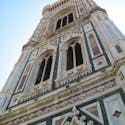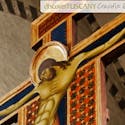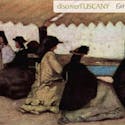Arnolfo di Cambio, important and innovative architect and sculptor, that together with the great Tuscan painter Cimabue, laid the foundation of the Renaissance revolution. He was very productive and several works are displayed in Florence, as well as in famous international collections.
His most renowned work is certainly the facade of Florence Cathedral, that was dismembered during 16th century. Although we can admire some original sketches and a beautiful reconstruction of it, as well as some statues and fragments inside the Opera del Duomo Museum.
His Life
Arnolfo di Cambio was born in Colle Val d'Elsa around 1240-45. We don't know much about his life. According to Vasari he was son of an important German architect, Lapo di Cambio, who worked at several projects across Italy.
We certainly know that from 1265 he worked as chief assistant of Nicola Pisano and collaborated to the realization of the beautiful pulpit within Siena Cathedral. About 1276 he moved to Rome, working both as architect and sculptor for King Charles I of Anjou. He was in Rome until 1293.
In 1294-95 he moved to Florence, where he worked to the architectural and urban renovation of the city. He realized the most important city landmarks, such as the Cathedral, Santa Croce Church and Palazzo Vecchio.
Arnolfo worked also to the foundation of the so-called new lands as San Giovanni Valdarno. He died in Florence in 1302-10.
His Works
Arnolfo di Cambio is one of the greatest and most innovative artists between 13th and 14th century. He inspired the new artistic language later used by Giotto and the Renaissance artists. According to Vasari he was a versatile figure who took architecture back in the spotlight after the Middle Ages.
Even though he worked in several places, such as Rome, Siena, Naples, Orvieto, Perugia, Bologna, most of his works are in Florence where he worked from 1294 until his death. He realized some of the most famous landmarks of the city.
Arnolfo's most renowned project was the facade of Florence Cathedral, that was smembered in late 16th century. At the Opera del Duomo Museum are displayed some original sketches, several statues and fragments of Arnolfo's original facade. There are also a beautiful and detailed reconstruction, as well as the beautiful Madonna of the Nativity, inspired by Etruscan funeral monuments. The Museum displays also the stunning Monument to Pope Boniface VIII (1300).
In Florence he worked also at the construction of Palazzo Vecchio, Santa Croce Church and probably of Badia Fiorentina, as documented by the archives.
Other important works by Arnolfo are the Portrait of King Charles of Anjou I (1277) in Campidoglio, the ciborium of the Church of San Paolo fuori le mura in Rome, and the beautiful Monument to Cardinal de Braye (1282) in the Church of San Domenico in Orvieto.
At 700 years from his death Florence celebrated Arnolfo's genius with an extraordinary exhibition at the Opera del Duomo Museum. "Arnolfo, at the origins of the Florentine Renaissance" displayed for the first time about 100 works by the artist, giving the opportunity to see the partial reconstruction of the facade of Florence Duomo.



